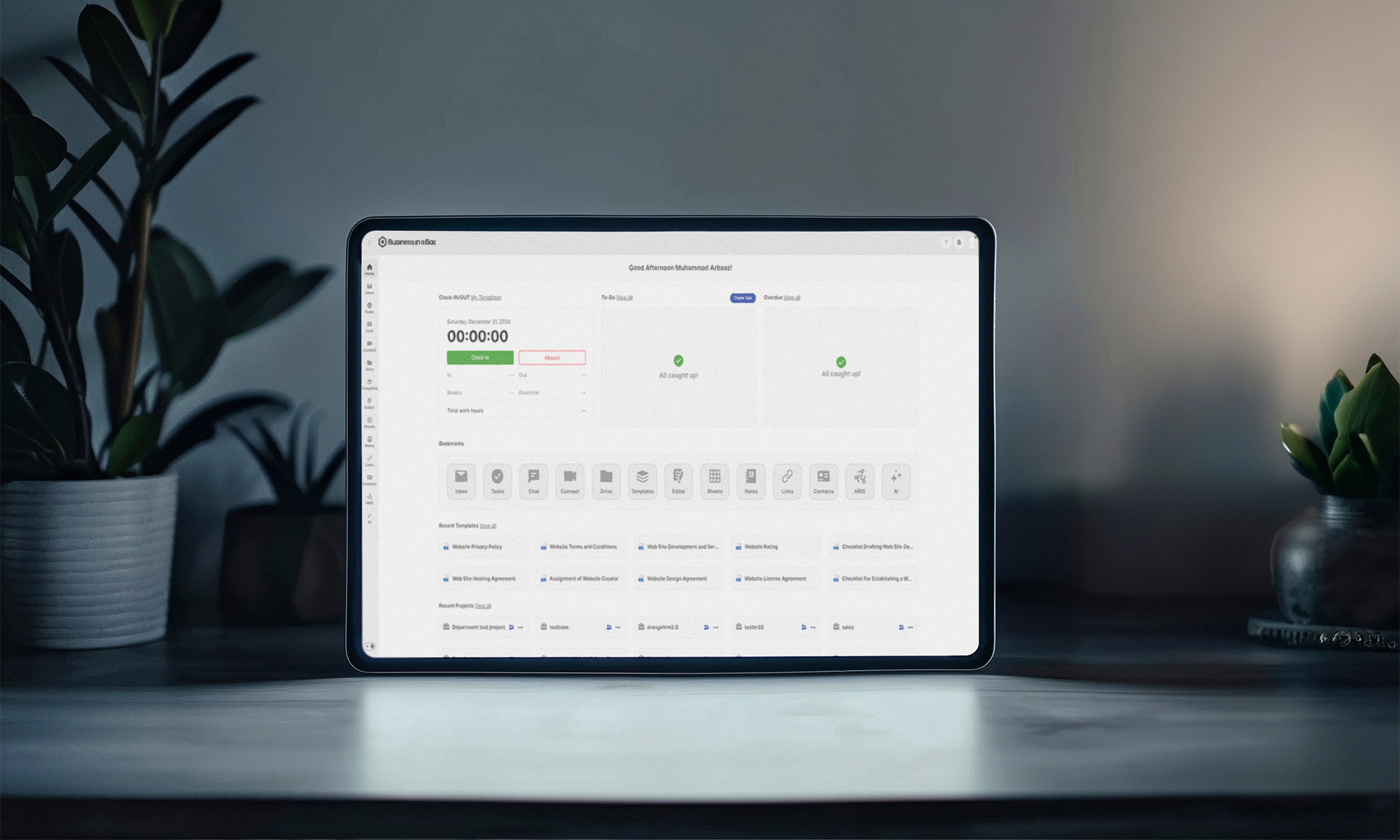Introduction: The Modern Business Puzzle
Running a small or midsize business today often feels like assembling a jigsaw puzzle — with pieces from seven different boxes that don’t quite fit together.
One app for tasks.
Another for chat.
A third for video calls.
Then document storage, HR, CRM, and finance — all separate, all subscription-based, and none of them truly connected.
At first, it seems manageable. Each tool solves a specific problem. But over time, this patchwork stack becomes a monster. Teams waste hours switching between apps, files get lost, updates go unseen, and leaders lose visibility into what’s really happening.
This isn’t just an inconvenience. It’s a silent killer of productivity and profit.
That’s why smart businesses around the world are consolidating — replacing their fragmented stack with unified platforms like Business in a Box, which bring every function under one roof.
Because the future of work isn’t about using more tools.
It’s about using one intelligent system that works for you.
1. The Problem: App Overload Is Crippling Small Businesses
According to Productiv’s 2024 SaaS Trends Report, the average company now uses 13 different SaaS applications. Even small businesses use between 7 and 12 apps daily just to run basic operations.
The hidden costs are staggering.
1.1 Context-switching fatigue
Harvard Business Review found that frequent context switching — jumping between tools, tabs, and interfaces — can reduce productivity by up to 40 percent. Every notification, login, and sync delay drains mental energy and focus.
1.2 Data silos
When information lives in disconnected systems, insights disappear. Sales doesn’t see what operations is doing; HR can’t track productivity; documents get duplicated and outdated.
1.3 Lost accountability
Who owns what? Which file is final? Which message is the latest? Fragmented tools make accountability blurry.
1.4 Subscription sprawl
Each app adds another invoice, another renewal, another security risk. Gartner estimates that businesses overspend by 25 percent on under-utilized software each year.
In short: the more apps you add, the less control you have.
2. The Shift: From App Chaos to All-in-One Clarity
A new wave of platforms is reversing this fragmentation.
Instead of dozens of disconnected tools, businesses are consolidating into all-in-one systems that centralize work, communication, and knowledge.
Think of it as moving from a “tool stack” to a business operating system.
And at the forefront of this shift is Business in a Box — designed specifically to help small and midsize organizations operate with the speed, visibility, and simplicity of large enterprises, without the complexity.
3. What All-in-One Really Means
“All-in-one” is more than a buzzword. It’s a philosophy of work.
3.1 One login, one workspace
Employees don’t waste time toggling between accounts. Everything — projects, tasks, documents, messages, and meetings — lives in one secure environment.
3.2 Connected workflows
Every part of the business talks to every other part. A task links to its documents, chat thread, deadlines, and team.
3.3 Unified data
Information is consistent across modules. Update it once, and it’s reflected everywhere. That means accurate reporting, fewer errors, and smarter decisions.
3.4 Simplicity at scale
Adding users, departments, or locations doesn’t multiply complexity — it simply extends the same clean, integrated system.
Business in a Box was built on these principles from day one.
4. How Business in a Box Replaces Seven Apps with One
Let’s look at the most common software every SMB uses — and how Business in a Box replaces them natively.
| Traditional Tool | Purpose | Replaced by Business in a Box Feature |
| Asana / Trello / ClickUp | Task & project management | Team & Task Manager |
| Slack / Teams | Messaging & collaboration | Built-in Chat |
| Zoom / Meet | Video calls | Integrated Video Meetings |
| Google Drive / Dropbox | File storage & sharing | Document Management & Drive |
| Outlook / Gmail | Internal communications | Unified Inbox |
| HR tools (BambooHR, Monday HR) | Team tracking & performance | People & Productivity Dashboard |
| Template libraries / Google Docs | Documents & workflows | 3,000+ Ready-to-Use Templates |
One system. One subscription. One secure source of truth.
5. The Real ROI of Consolidation
Switching to an all-in-one platform doesn’t just simplify operations — it directly impacts your bottom line.
5.1 Time savings
Employees waste an average of 9.3 hours per week toggling between tools (Atlassian 2024 Study). That’s more than a full workday reclaimed per person.
5.2 Cost reduction
Consolidating reduces overlapping subscriptions. Typical savings range from 20 – 35 percent of annual software spend.
5.3 Faster onboarding
New hires can start immediately — one login, one system to learn. No more multi-app training marathons.
5.4 Improved data accuracy
A single database means fewer duplicates, better version control, and higher trust in the numbers.
5.5 Happier teams
Less chaos equals lower stress. Gallup’s 2023 State of Work report found that clarity of tools and workflow is one of the top five drivers of employee engagement.
6. Inside Business in a Box: The Engine of Clarity
6.1 Team & Task Management
Plan, assign, and track work visually. Every task connects to files, comments, and deadlines — with time tracking built in for accountability.
6.2 Document Management
Upload, edit, share, and store company documents securely. Version history and permissions keep everything organized.
6.3 Live Chat & Video Meetings
Collaborate instantly — whether you’re across the hall or across the world. No third-party apps needed.
6.4 Unified Inbox
Centralize communications. See messages, project updates, and system alerts all in one feed.
6.5 3,000+ Business Templates
From contracts and policies to proposals and HR forms, ready-made templates save hours of drafting time.
6.6 AI Enhancements (Coming Soon)
In the next 12 months, AI assistants will automate reporting, summarize meetings, and suggest task optimizations — bringing predictive intelligence into everyday workflows.
Together, these features create the most complete, user-friendly business platform ever built for SMBs.
7. The Hidden Benefit: Mental Clarity
Technology isn’t just about efficiency — it’s about peace of mind.
When everything your team needs is in one place, mental load drops dramatically.
You don’t spend energy wondering where things are or who’s responsible.
That clarity leads to flow — the state of effortless productivity where people do their best work.
As one Business in a Box user said,
“It’s like going from a noisy open office to a calm, organized studio. We finally have space to think again.”
That’s the real transformation: from noise to focus.
8. Why Now: The Timing Is Perfect
The global software market is saturated. Most SMBs are hitting a breaking point with fragmented systems.
At the same time, cloud technology and AI are making it possible to unify everything intelligently.
- Tech exhaustion is real — 62% of small business owners say they’re overwhelmed by too many tools (Salesforce SMB Report 2024).
- Integration demand is surging — 78% plan to consolidate systems within the next two years.
- AI readiness is key — unified platforms make it easier to apply automation and analytics later.
Switching now means you’ll simplify today and be ready for the next wave of intelligent business software tomorrow.
9. Case Example: From Fragmentation to Flow
Let’s imagine a 15-person marketing agency.
They use 10 different apps: Trello for tasks, Slack for chat, Zoom for calls, Google Drive for files, and several others.
Problems:
- Team spends 8 hours/week per person switching tools.
- Projects get delayed because updates live in chat instead of the task system.
- Client folders are messy, with duplicate versions.
After switching to Business in a Box:
- All communication, files, and tasks live together.
- Time tracking reveals where billable hours leak.
- Daily AI summaries keep leadership informed automatically.
Within 60 days, the agency reports:
- 32% faster project delivery
- 28% reduction in software costs
- Higher team satisfaction
This is what “one platform” really means — clarity, speed, and measurable ROI.
10. The Future: One Platform, Infinite Potential
In the next few years, every company will migrate toward an all-in-one model.
Just as operating systems unified personal computing, business operating systems will unify organizational work.
The winners won’t be those using the most apps — they’ll be those using the best-connected platform.
Business in a Box isn’t just part of this trend — it’s leading it.
With AI-powered assistants, cost tracking, and automated reporting on the horizon, it’s evolving from a productivity suite into an intelligent partner that helps run your entire business.
Conclusion: Simplify to Multiply
Growth doesn’t come from adding more tools.
It comes from removing friction.
Every entrepreneur reaches a moment when the tech stack stops helping and starts holding them back. That’s when it’s time to simplify — to consolidate, centralize, and regain control.
Business in a Box was built for that moment.
It gives you everything your business needs to stay organized, aligned, and productive — all in one secure, intelligent platform.
No more app chaos.
No more scattered data.
Just clarity, focus, and growth.
Because the smartest businesses of tomorrow will be the simplest ones today.
Start Your Free Trial Today
Unify your work, your team, and your results with Business in a Box — the world’s most complete business management platform.
Start your free trial now at www.business-in-a-box.com
Experience what it feels like when everything finally works together.







